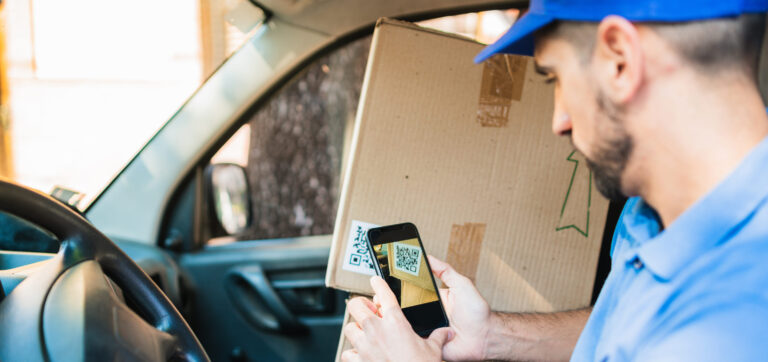The last years have left deep marks. Confronted with remote work, lockdowns, and social distancing, people changed their ways of living. When they couldn’t shop in person, they shifted to ordering online: The package delivery industry saw demand explode during the lockdown. Some of these effects persist to this day.
A constantly rising parcel volume is one of them. This presents a serious challenge for package delivery businesses, because customers still expect delivery within 2–3 business days at the same low cost.
Thus, peak times in last-mile delivery demand higher precision and efficiency at every stage of the value chain than ever before. The loading process of packages back at the parcel center, rising fuel and labor costs, and the pressure on drivers to perform well with no time to spare make last-mile delivery the most expensive, error-prone, and time-consuming part of the supply chain.
One way to simplify your employees’ workflows to save time and reduce costs is to integrate barcode scanner software into your company’s mobile app and let your employees work with smartphones.
Mobile barcode scanning on smartphones or tablets combines all the benefits of conventional handheld devices – such as speed, precision, and ruggedness – while offering a wider range of helpful features and more flexibility.
How to use smartphones in last-mile delivery
There are different approaches to using smartphones in last-mile delivery, from BYOD to business-only phones. They differ in how much control the company has over the devices – which has far-reaching consequences.
Let’s now look at four basic device strategies and their advantages and disadvantages.
BYOD
The BYOD (“bring your own device”) strategy allows employees to use their own mobile devices for work purposes. It is widely used as it is both flexible and cost-effective.
The key advantage is that enterprises don’t need to purchase expensive hardware or invest in maintenance and storage. Furthermore, they don’t have to wait for device delivery and onboarding, as employees are already familiar with their devices.
However, there are some disadvantages to BYOD. Firstly, the sheer variety of devices makes it difficult to ensure compatibility. Additionally, device security is the employees’ responsibility. Consequently, handling sensitive work-related information on these personal devices inevitably raises security concerns.
An enterprise BYOD strategy must account for these issues. In doing so, it has to balance employees’ privacy rights against compliance with data protection laws and industry regulations.
CYOD
CYOD (“choose your own device”) trades some of BYOD’s flexibility for increased company control.
Here, employees choose their device from a premade selection. Because the company provides the mobile device, it decides what hard- and software is used, effectively erasing compatibility issues. Additionally, it has a say in implementing security measures.
Implementing CYOD does mean that a device inventory has to be stocked and maintained. However, the limited device pool means that maintenance work is relatively simple to plan.
COPE
COPE (“company-owned, personally enabled”) is similar to CYOD in that the company provides its employees with a mobile device. However, even though they are allowed to use them privately, employees cannot choose their devices. The private use familiarizes the employees with their working tools and can benefit employer branding.
As with all personal use, some security risks remain. Integration and device management, however, is easier for the company thanks to the small number of device models.
COBO
COBO (“company-owned, business only”) eliminates that security risk, as the devices provided are only used for work-related purposes. There is also no overlap between personal and business-related data.
Furthermore, hardware administration and support are more manageable, as companies can choose the devices that best fit their requirements.
Turn any smartphone into a powerful package scanner
Whichever strategy you choose, there are several advantages to using a mobile device as a package scanner instead of dedicated handheld devices.
Smartphones are multi-purpose devices
In contrast to traditional handheld scanners, smartphones can do more than just scan barcodes. In last-mile, they can be used for:
- Loading the delivery truck: Couriers can scan all the packages they load into their delivery trucks using an integrated barcode scanner.
- Navigation: Smartphones offer built-in navigation, which employees are used to from personal use.
- Real-time delivery information: Customers want to know where their package is at any time during delivery. A smartphone can send location updates.
- Capturing signatures / PoDs: Any smartphone can collect proof of delivery by letting the recipient sign right on the touchscreen.
- Communication: Whenever problems arise, couriers can use their smartphones to contact headquarters, senders, or recipients.
Lower costs
Traditional handheld barcode scanners are bulky and cumbersome. Modern solutions often resemble ordinary smartphones, but they don’t offer the same flexibility. This makes them expensive single-purpose devices.
Mobile barcode scanning on smartphones or tablets offers all the benefits of conventional handheld devices, such as speed, precision, and ruggedness – but at a lower cost. Using mobile devices as barcode scanners is cheaper in the long run, especially in CYOD and other strategies where you can decide which device to buy.
Features you should look out for
When choosing a Barcode Scanner SDK to turn your employees’ smartphones into a multi-purpose scanning tool, look out for the following features:
- Batch Scanning: Your smartphone should be able to scan several barcodes one after the other. When delivering several packages to the same household, your couriers can scan them all without starting over for every single one, speeding up the scanning process.
- Multi-Scanning: A multi-scanning feature allows your employees to capture several barcodes in the camera viewfinder at once. This is especially helpful when couriers load their trucks at the beginning of a shift, as they don’t need to interrupt loading to scan every package.
- Find & Pick: Searching for the right package from a jam-packed truck takes a lot of time. A find & pick feature enables your employees to pre-define desired barcode values that will then be highlighted in the live view.
- Data Capture: Certain products require age verification upon delivery. With integrated data capture software, your employee’s smartphone can scan different ID types and extract data from them, speeding up the verification process.
Meet the Scanbot Barcode Scanner SDK
With the Scanbot Barcode Scanner SDK, your employees can scan all standard 1D and 2D barcodes in 0.2 seconds. Features such as Multi-Scanning maximize efficiency and speed in last-mile delivery.
The Scanbot Barcode Scanner SDK scans even damaged or blurred barcodes in poor scanning conditions such as bad lighting – and without requiring an internet connection.
You don’t have to worry about distance, as barcodes can be scanned from more than 1 meter away. On top of that, the Scanbot SDK’s user guidance features lead even less experienced couriers to the perfect scan.
You don’t have to spend months developing a barcode scanning feature – integrating the Scanbot Barcode SDK only takes a few hours. Feel free to contact our developers at any time if you have any questions along the way.

Want to learn more about the Scanbot Barcode Scanner SDK?
Here’s what you can do next:
- Read our in-depth booklet about how a Barcode Scanner SDK can help your company save time and money.
- Try the demo app to get a glimpse of the SDK’s functionalities.
- Get a free 7-day trial license to test the SDK in your project.
- Get in touch with our Sales team to discuss your use case with our solution experts.
